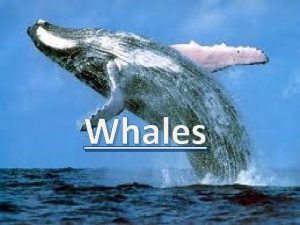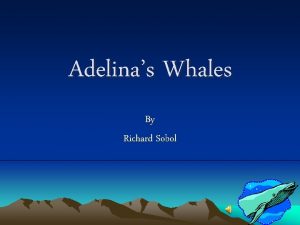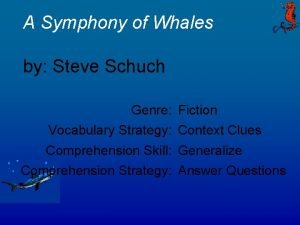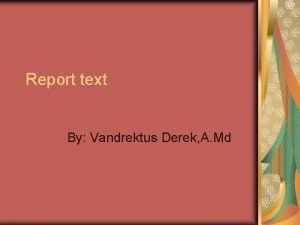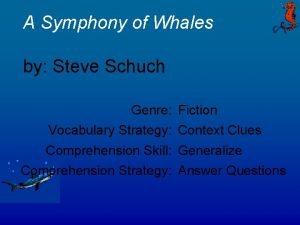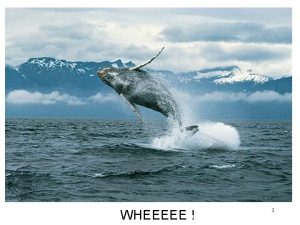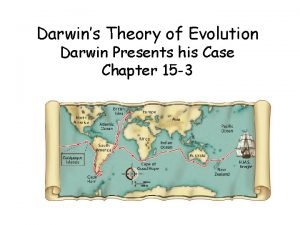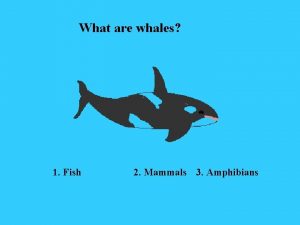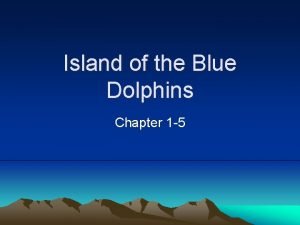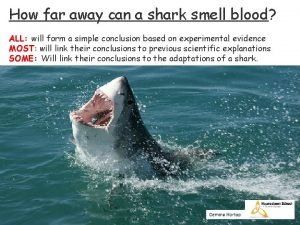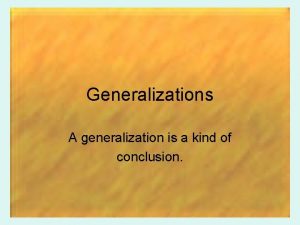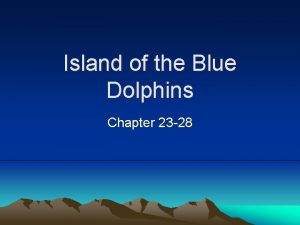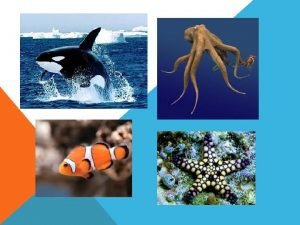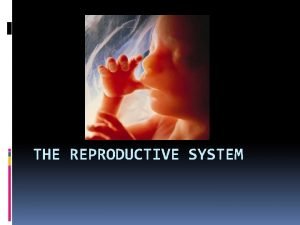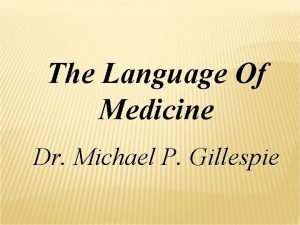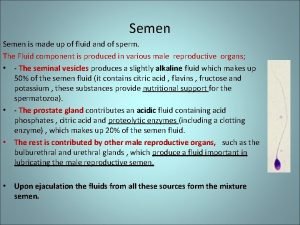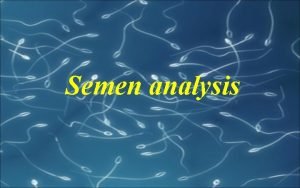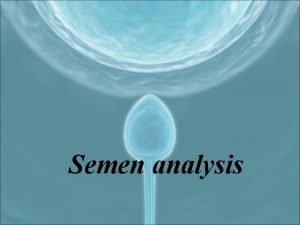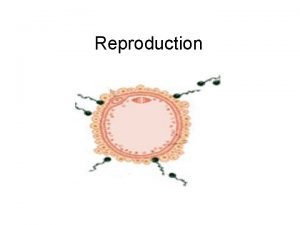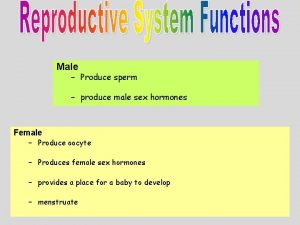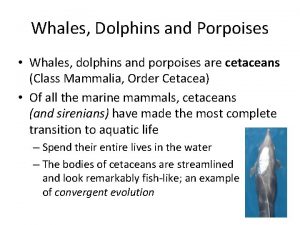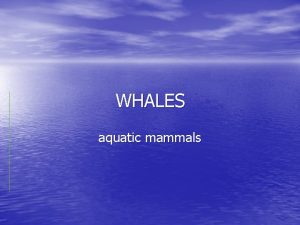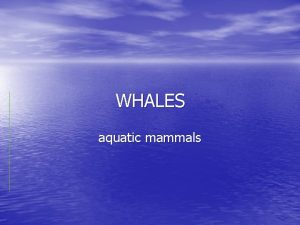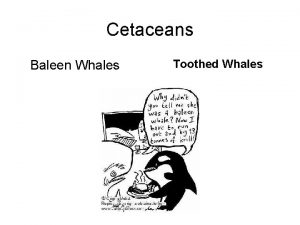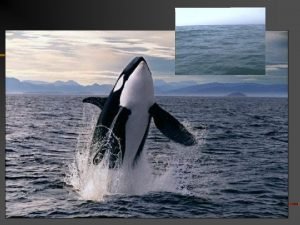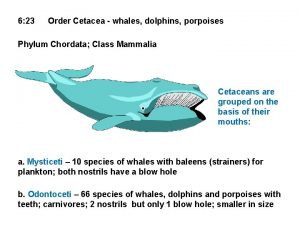unusual examples dolphins whales sperm whale off the


























































- Slides: 58


unusual examples dolphins whales

sperm whale (off the coast of Chilé)

http: //www. nature. com/news/2008/080221/ multimedia/news. 2008. 613. mov

Sleep 135, 000 hours of your life asleep (1/3) How do we study sleep? What do we know about it? What are some sleep disorders What do we know about brain regions and neurotransmitters involved in sleep?

How do we study sleep typically in a sleep lab…. EEG – electroencephalogram EPSPs of cortical neurons ◦ EMG – electromyelogram looking at muscle tone (usually electrodes on jaw) ◦ EOG – electrooculogram looking at eye movements (electrodes around eye)


EEG look at 2 components of the EEG 1. the frequency of the wave (n of peaks/unit time) – tells you about the number of cortical neurons generating EPSPs 2. the amplitude of the wave (height of wave) – – tells us about the n of EPSPs that occur at the same point in time n of neurons firing in synchrony

high frequency, low amplitude beta waves

start seeing higher amplitude, lower frequency alpha waves

1 st sleep stage – still fairly high frequency low amplitude but clear difference from alert and awake state often will deny being asleep

15 min later (if not disturbed) stage 2 – characterized by high frequency low amplitude sleep spindles and high amp low f k complexes role of these wave forms? –

15 min later if not disturbed stage 3 – first of the slow wave sleep stages characterized by delta waves high amplitude, low frequency waves less than 50% delta waves is stage 3; more than 50% stage 4 (15 min later)

slow wave sleep during SWS, parasympathetic NS activity seems to predominate (hr and bp decrease, respiration decreases, gastric motility increases) person relaxed but still motor activity; normal sleeper changes position every 20 min or so stage 4 deepest stage ?

typical 90 min sleep cycles goes from ◦ stage 1 (15 min) to stage 2 (15 min) to stage 3 (15 min) to stage 4 (15 min) to stage 3 (15 min) to stage 2 (15 min) to first bout of REM sleep

Characteristics of REM sleep low amplitude, high frequency desynchronous EEG


Characteristics of REM sleep low amplitude, high frequency desynchronous EEG rapid eye movement (REM) narrative dreams muscle atonia ◦ look at motor cortex – extremely active but descending motor pathways paralyzed ◦ REM without atonia penile erections and vaginal secretions deepest stage? ◦ incorporate things into our dreams ◦ more likely to spontaneously awaken

Some characteristics of REM changes in amount of time spent in REM over the night


Some characteristics of REM changes in amount of time spent in REM over the night maturational changes in pattern ◦ species with underdeveloped CNS – spend more time in REM


Some characteristics of REM changes in amount of time spent in REM over the night maturational changes in pattern ◦ species with underdeveloped CNS – spend more time in REM ◦ human newborns ~ 50% sleep time in REM ◦ human premies ~ 80% sleep time in REM

Why do we sleep? evolutionary theory ◦ predictions…… restoration and repair

Evolutionary Theory Sleep more if: ◦ No predators ◦ Safe place for sleeping ◦ Dangerous to yourself in the dark Sleep less if: ◦ Fear of predation ◦ Food of low nutritional value

Why do we sleep? evolutionary theory restoration and repair ◦ marathon runner studies

What happens with sleep deprivation?

Sleep disorders 1. Insomnia

Sleep disorders 1. Insomnia - primary cause - sleep medications

Sleep disorders 1. Insomnia - primary cause - sleep medications - develop tolerance; REM rebound


History of pharmacological treatments for insomnia

pharmacological txt short-acting benzodiazepenes ◦ triazolam (Halcion®)


pharmacological txt short-acting benzodiazepenes ◦ triazolam (Halcion®) problems with BZ tolerance REM suppression (and REM rebound) WD


Non-Benzodiazepine Hypnotic Drugs Zolpidem- (Ambien) ◦ ◦ non hypnotic sedative Also a muscle relaxant and anticonvulsant Still works on GABA A receptors Works quickly (15 min) and with a short ½ life (how quickly it clears out of the body

The pineal gland releases hormone melatonin at night

Ramelteon (Rozerem) ◦ ◦ First in a new class of sleep medications non BZ non sedative melatonin agonist

Sleep disorders 1. Insomnia - primary cause - sleep medications - develop tolerance; REM rebound - we are often poor estimators of how much sleep we get

-sleep apnea – difficulty sleeping and breathing at the same time - two types - 1. CNS mediated – very rare - 2. obstructive sleep apnea- main cause

treatments weight loss, reducing alcohol consumption (or other muscle relaxants), elevated sleeping, CPAP machine – continuous postive airway pressure surgical procedures to remove or tighten tissue

SIDS – sudden infant death syndrome ◦ possible link

Insomnia Nocturnal myoclonus – twitching of the body, usually the legs, during sleep – most are not aware of why they don’t feel rested (now called periodic limb movement disorder); involuntary Restless legs – sufferers complain of legs being uncomfortable that prevents sleep- can occur when awake or asleep Txt can include DA agonists; anticonvulsants Copyright © 2006 by Allyn and Bacon

REM-related sleep disorder Narcolepsy ~ 250, 000 people in US ◦ symptoms: uncontrollable recurring sleep during daytime (usually during mundane tasks) ◦ subcategories cataplexy hypnagogic hallucinations REM sleep behavior disorder

often (not always) older males often (not always) associated with other neurodegenerative diseases

Neuroanatomical regions and NT brainstem structures – pons, medulla abnormalities in noradrenergic, cholinergic, and serotonergic systems, seems to exist in the pathogenesis of RBD clonazepam (Klonopin) ◦ anticonvulsant – ◦ benzodiazpene


Narcolepsy unusual sleep characteristics ◦ short latency to REM ◦ persistent muscle tone ◦ excessive muscle twitching Treatment for narcolepsy ◦ stimulants; caffeine, ◦ GHB – gamma hydroxy butyrate**

genetics of narcolepsy ◦ people with family history + are 50 X more likely to have disorder than families without history + ◦ animal species


Non-REM sleep disorders ◦ Enuresis ◦ Sleep walking

brain regions and NT involved in sleep locus coerulus- in hindbrain (NE transmitter) ◦ important for arousal What does it do during sleep?


brain regions and NT involved in sleep and arousal locus coerulus- in hindbrain (NE transmitter) ◦ important for arousal What does it do during sleep? ◦ active when awake; inhibited during sleep – particularly REM

What about other nt and regions? Acetylcholine – in pons – important for REM onset ◦ ACh. E poisoning (mustard gas or pesticides) people go into REM immediately after falling asleepvery vivid dreams and nightmares! PGO waves –

Serotonin (5 HT) Increases in tryptophan – increases in 5 HT Increases in 5 HT – increases in drowsiness (? )

 Why are sperm whales called sperm whales
Why are sperm whales called sperm whales Cetaceans
Cetaceans Dolphins food web
Dolphins food web Sperm whale wiki
Sperm whale wiki Sperm whale range map
Sperm whale range map Is krill an autotroph
Is krill an autotroph Daring rescue of whale off farallones
Daring rescue of whale off farallones Unusual
Unusual Elbows off the table fingers off the food song
Elbows off the table fingers off the food song The hind leg bones in a whale are examples of
The hind leg bones in a whale are examples of Enchanted learning whales
Enchanted learning whales How do whales reproduce sexually
How do whales reproduce sexually Whales use to walk on land
Whales use to walk on land Lose the blubber go vegetarian
Lose the blubber go vegetarian Save the whales readworks answer key
Save the whales readworks answer key Whale atavism
Whale atavism Adelina's whales
Adelina's whales Symphony of whales
Symphony of whales Whales are sea living mammals they therefore
Whales are sea living mammals they therefore Adelina's whales reading street
Adelina's whales reading street Symphony of whales read aloud
Symphony of whales read aloud Types of whales
Types of whales Characteristic of whale
Characteristic of whale Land whales
Land whales Whales have vestigial legs. this suggests they _____.
Whales have vestigial legs. this suggests they _____. 2friends 1 fish
2friends 1 fish The story of the three whales
The story of the three whales Whales have vestigial legs. this suggests they _____.
Whales have vestigial legs. this suggests they _____. Adelinas whales
Adelinas whales Abnormal word order example
Abnormal word order example Island of the blue dolphins vocabulary words by chapter
Island of the blue dolphins vocabulary words by chapter Island of the blue dolphins vocabulary chapter 1-5
Island of the blue dolphins vocabulary chapter 1-5 Blind cetacean
Blind cetacean Where do dolphins live
Where do dolphins live Dolphin habitat map
Dolphin habitat map Difference between generalization and conclusion
Difference between generalization and conclusion What biome do bottlenose dolphins live in
What biome do bottlenose dolphins live in Behavioral adaptations of dolphins
Behavioral adaptations of dolphins Writing about dolphins
Writing about dolphins Description of dolphins
Description of dolphins Chapter 28 island of the blue dolphins
Chapter 28 island of the blue dolphins Island of the blue dolphins map
Island of the blue dolphins map Outline of dolphins
Outline of dolphins Facts about stingrays
Facts about stingrays What do dusky dolphins eat
What do dusky dolphins eat Echolocation sonar
Echolocation sonar Reptiles carnivores
Reptiles carnivores Island of the blue dolphins chapter 11
Island of the blue dolphins chapter 11 Reproductive system vocabulary
Reproductive system vocabulary Which term means “no sperm or semen are produced”?
Which term means “no sperm or semen are produced”? Path of sperm
Path of sperm Where is seminal fluid made
Where is seminal fluid made Semen protein
Semen protein Slidetodoc.com
Slidetodoc.com Sperm with 2 tails
Sperm with 2 tails Male gonad
Male gonad What happens when a double yolk egg hatches
What happens when a double yolk egg hatches Where semen is stored
Where semen is stored Bulbourethral gland
Bulbourethral gland











